BIOCH 200: Slide 6 Biological Membranes (Lipids, Structure + Transport)
1/104
There's no tags or description
Looks like no tags are added yet.
Name | Mastery | Learn | Test | Matching | Spaced |
|---|
No study sessions yet.
105 Terms
What are lipids? Characteristics?
Compounds that are mostly:
Nonpolar
Hydrophobic
What are 4 types/ examples of lipids?
Fatty Acids
Triacylglycerol (Contains F.A)
Membrane lipids (Contains F.A.)
Cholesterol
What makes up fatty acids?
Long chain Hydrocarbons (nonpolar) + Carboxylic acid (polar)
General formula = CH3(CH2)nCOO-
What is the charge of Fatty Acids @ pH 7, and thus what is the pka
Negative
pka = less than 7
Are Fatty acids Amphipathic?
Yes
there are polar + Non polar portions
Sat vs. Unsat. F.A.
Sat = No double bonds
Unsat = Double bonds
What conformation cis/ trans are most naturally occurring doubles in F.A.’s in?
CIS/Z
How do double bonds in CIS conformation affect the F.A?
LOWERS boiling point
introduces kinks
What us the shorthand notation for F.A.’s?

Where do you start numbering the carbons on a F.A?
Carbonyl Carbon = 1
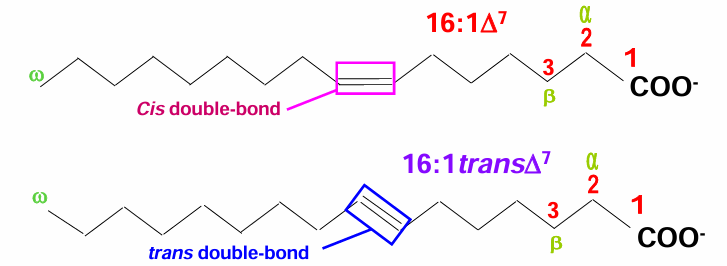
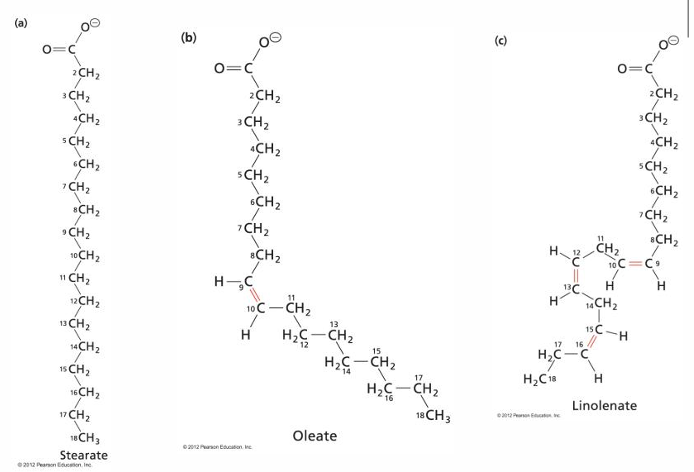
What are the shorthand notations for these?
a) 18:0
b) 18:1 delta 9
c) 18:3 Delta 9,12,15
What 2 characteristics of F.A’s increase the M.P.?
Longer Chain = high M.P.
LESS double bonds = High M.P.
Of the 2 characteristics: Length vs. Unsaturation (# DB) which has a greater effect on the melting point?
UNSATURATION = greater effect
TRUE or FALSE: the better F.A can pack together the higher the melting point?
TRUE
What is the ranking of the 4 possible combinations of Length and Unsaturation from highest melting point to lowest?
Long sat(low # BD)
Short sat.(Low # DB)
Long Unsat.
Short Unsat.
Do Cis or Trans F.A. pack better
TRANS: adopt diff (more linear) shape than cis
What is one Method of storing F.A.s"?
Triacylglycerol (TAG)
3 acyl chains (from FA) attached to a glycerol
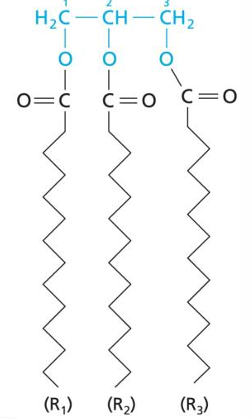
Are TAG’s amphipathic?
No
are TAG hydrophobic or hydrophilic?
HIGHLY hydrophobic
By what type of link do acyl chains attach to the glycerol? (TAG)
Ester-linked
Will the acyl chains on TAG’s always be the exact same?
No, Mixed TAGs are most common
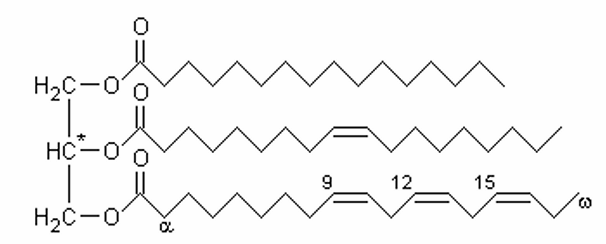
What are the 3 Membrane lipids
Glycerophospholipids
Sphingolipids
Cholesterol
Of the 3 membrane lipids, which contain fatty Acids?
Glycerophospholipids + sphingolipids
cholesterol = not contain F.A. as part of membrane (just associate with membranes)
Are membrane lipids amphipathic?
YES
What is the general structure of glycerophospholipids? How are they the same or diff from TAGs
Same: Glycerol w acyl chains attached covalently (Non-amphipathic)
Diff: ONLY 2 acyl chains
Additional PHOSPHATE HEAD (what makes it amphipathic)
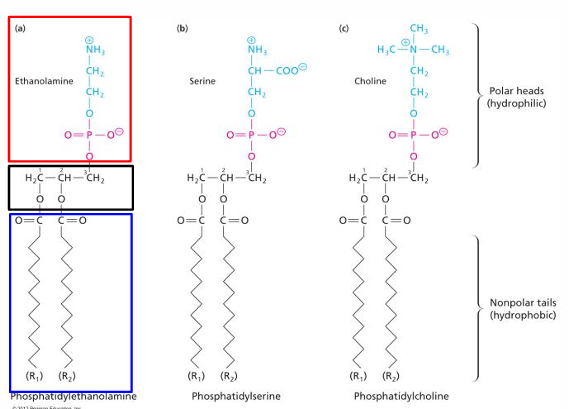
General Cholesterol structure
Rigid structure (rings)
Is cholesterol strongly or weakly amphipathic?
VERY Weakly
majority = hydrophobic (27 Carbons
1 OH group
What % of the mammalian plasma membrane is made up of cholesterol? (don’t know how important)
~ 30%
Does cholesterol form membranes on its own?
NO
Micelles + bilayers? What environment do they form and why do they form
In water
They form because the arrangement is favorable
polar head = solvated by H2O + Hydrophobic head is hidden from H2O
What forms micelles and what forms bilayers?
FA = Micelles
Membrane lipids = Bilayers
What are Liposomes?
Spherical vesicles of membrane Bilayers
What is the environment on the inside of a liposome? What is the Environment between the 2 leaflets?
Inside = Aqueous compartment
Between = hydrophobic (lipid soluble)
Do TAGs form bilayers/micelles? Why?
NO
Non-amphiphilic + Structure does not support (3 acyl chains makes a triangle shape, cannot line up side by side)
Why can glycerophospholipids form bilayers?
Amphiphilic + structure = good
only 2 acyl chains = can line up side by side
What makes up the majority of biological membranes?
Bilayers
What kind of interactions are used to assemble Bilayers?
NON-COVALENT
van der waal
Are bilayers perfectly even like shown in texts books
NO
Head = different sizes
Tail = diff length
How does cholesterol associate with the membrane
Non-polar portion = inside the membrane
OH - associates with polar head group of other lipids
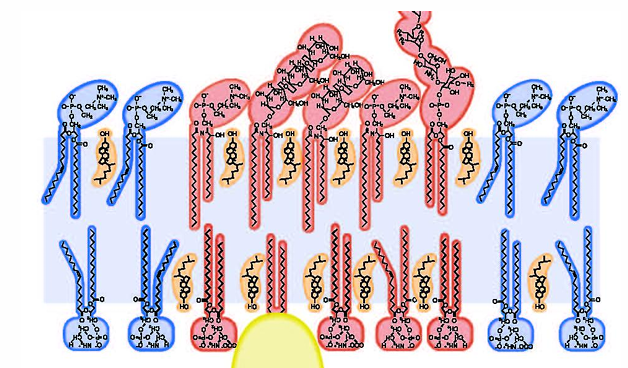
What is the transition temperature of a lipid bilayer?
AKA the MELTING temp
Temp at which it transitions from ordered to a more fluid state
dependent on acyl chain
What is the name of the phase of the bilayer below the transition phase? What about above?
Ordered gel
Disordered Liquid
Difference in transition temp between artificial and biological membranes
Artificial = NARROW transition temp
homogenous preparation
Biological = NOT
What causes the biological membrane transition temp to be not as sharp
Mixture of compounds (diff lipids/proteins)
How does the lipid composition of a biological membrane adapt to differences in temp?
Decreasing temp = More UNSAT. + SHORT FA
Increasing = opposite
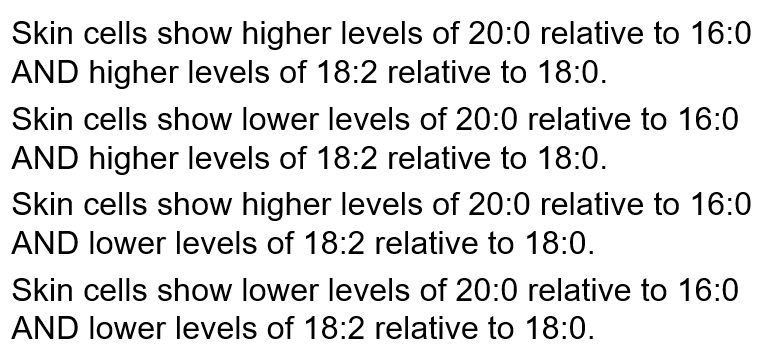
In humans FA composition in skin cells diff than internal organ cells b/c internal organs are @ higher temp. Which diff in composition is most likely to be observed
B
What does CHOLESTEROL do to the Fluidity of the lipid membrane?
Increases the Effective/usable TEMP RANGE for the membrane
How does cholesterol Increase the Usable range of membrane in low temps
Prevents close packing of acyl chains = more fluid
How does cholesterol Increase the Usable range of membrane in High temps
(ring structure = rigid) Decrease motion/disorder of acyl chains + INCREASING VAN DER WAAL interactions = more rigid
What 2 types of movement can a lipid undergo in a bilayer?
Lateral diffusion (side to side within same leaflet)
Transverse diffusion (flip-flop from one leaflet to the other)
Which type of movement in bilateral membranes is more common.
Lateral diffusion (fast + free)
little enegry barrier
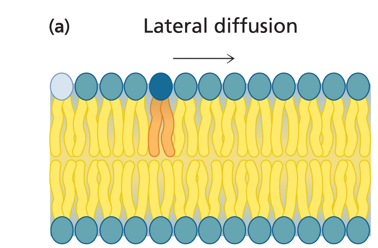
Why is transverse diffusion so unfavorable + slow
Need to transport POLAR head through the hydrophobic tails to get to the other side = significant energy barrier
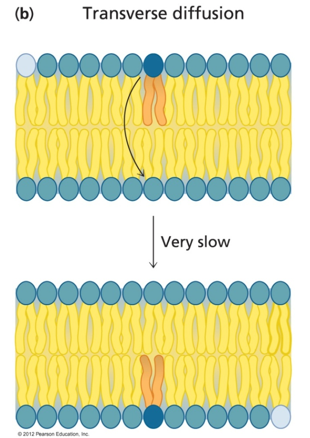
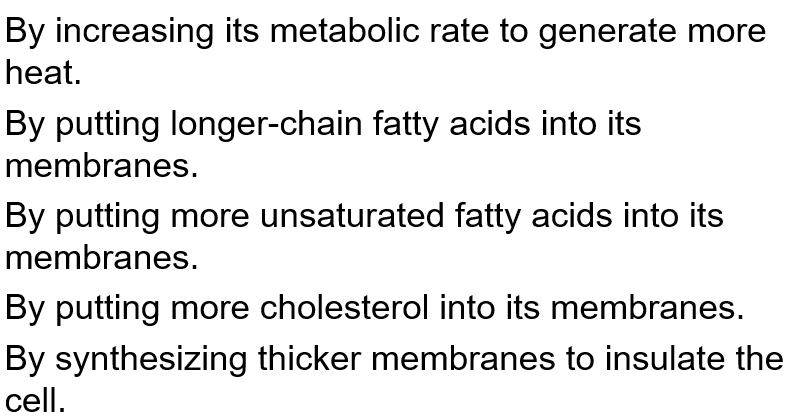
When a bacterium such as E.coli is shifted to a cooler environment, how does it compensate? How is it bacterium
C
Bacterium don’t synth cholesterol
How can transverse diffusion rates across a membrane be increased?
Flipases
What are Flipases?
Enzymes(membrane proteins) that allow for specific transportation
What are 3 types of membrane proteins?
Integral/ transmembrane
Peripheral
Lipid-linked
How do each of the three membrane proteins associate with the membrane?
Integral = Hydrophobic
Peripheral = Electrostatic
Lipid linked = Lipid prosthetic group (hydrophobic)
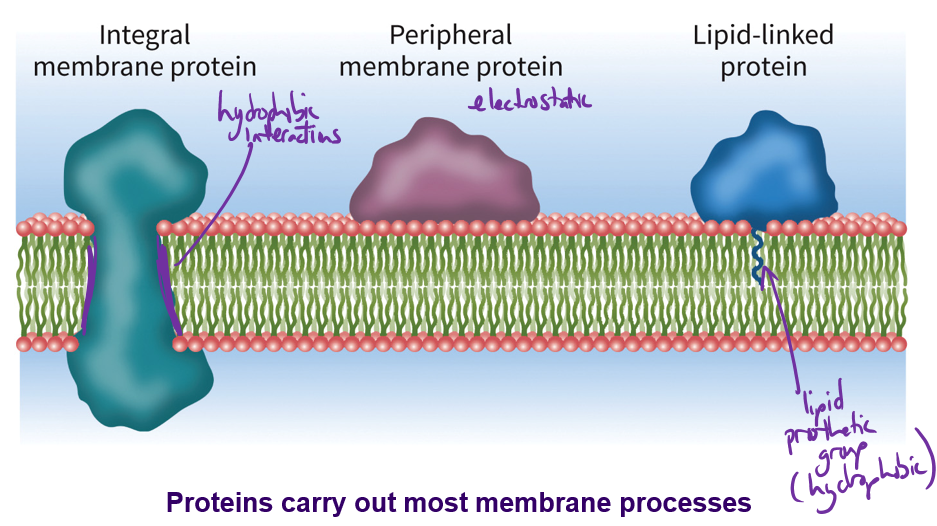
What type of membrane protein must it be when it comes to transporting things across/through a membrane
Integral/Transmembrane
What kind of amino acid side chains must be on the surface of the portion of the integral membrane protein that is in contact with he acyl chains?
Hydrophobic/ Non polar
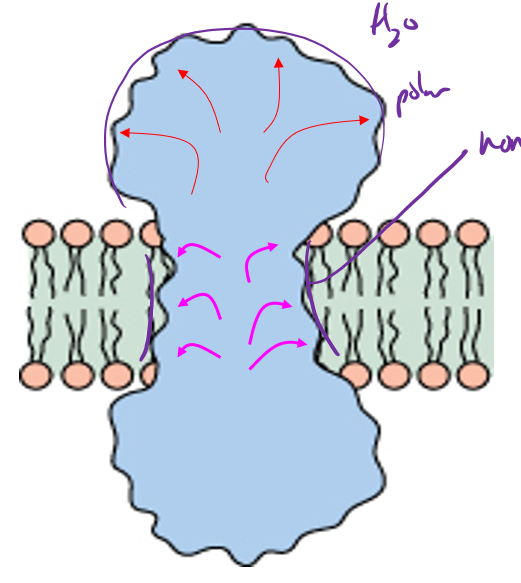
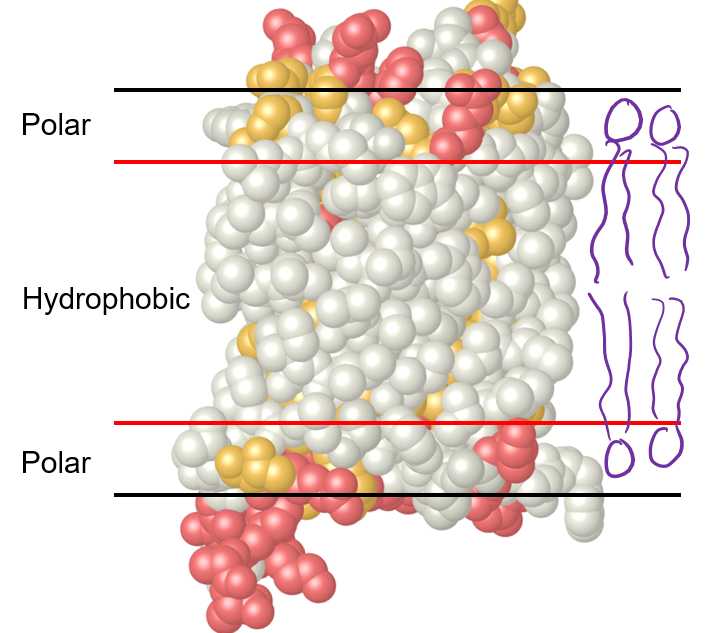
Which types of AA side chains are associated with each color of this integral membrane protein? and what do they each interact with?
Red = Polar charged —> interact with solvent
Yellow = Polar uncharged —> interact with polar head + solvent
White = Non-polar —> Interact with lipid tails
What are the 2 most common structures in PROTEINS that can cross a lipid bilayer?
Alpha-helices + Beta-sheets/barrels
True or false: amino acids that form a transmembrane alpha-helix = generally hydrophobic. Also ~ 20 AA can cross membrane as alpha-helix
True
Can cholesterol by itself form a bilayer? Why?
No
not amphiphilic enough
geometry does not allow
True or false: Membranes are dynamic, covalent, complex assembly, containing of lipids and proteins only
FALSE:
membranes are assembled using NON-COVALENT BONDS
carbohydrates are also present
True or false: Lipids move laterally but cannot easily undergo transverse diffusion. The opposite is true for proteins.
FALSE: BOTH lipids AND proteins move laterally but cannot easily undergo transverse diffusion
What may limit the movement of proteins in a lipid membrane?
Cytoskeleton
Where are carbohydrates attached on a membrane?
To the extracellular surface of some proteins and lipids
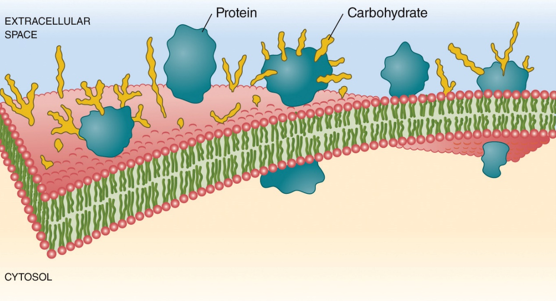
What molecules do not require proteins to cross a lipid bilayer? (diffusion)
Small non-polar
gases
hydrophobic molecules
small polar molecules
What substances require a proteins transporter to move across a membrane
Large polar molecules
glucose
Charged molecules
amino aci+ ions
What 3 things does the rate of simple unmediated diffusion depend on?
Size
Concentration gradient
Lipid Solubility
What are the 2 major types of TRANSPORT?
Active + Passive
What are the Delta G for each type of transport?
Passive = NEGATIVE
Active = POSITIVE
E = needed
For transport to occur what must l delta G be?
It must be NEGATIVE (less than 0)
What do transport proteins do in terms of transport?
They reduce the activation energy barrier
What are the 3 types of things that enable transport across membranes?
Porins
Ion channels
Transport proteins
How do Porins and Ion channels differ from transport proteins?
Porins and Ion channels do not undergo CONFORMATIONAL CHANGE while transport proteins DO
What type of transport do porins + ion channels provide?
PASSIVE only
Porins vs. Ion channels. Selectivity?
Porins = NON-selective
Ion channels = HIGHLY selective
What determines the selectivity of an ion channel?
The geometry of the pore + the side chains in it
Porins vs. Ion channels. Subunits?
ALL porins = HOMOTRIMERS (3 subunits)
Ions = many subunits (no set #)
How many pores does a porin have?
3
What are porins made up of? Alpha-helix or beta-sheet or beta-barrel?
3 Beta barrels that are identical
True or false: Transporter/ carrier proteins have membrane spanning pores?
FALSE
Are transporter/carrier proteins selective?
Yes
Are transporter/carrier proteins active or passive?
Can be either
How do transporter/carrier proteins work?
Conformational change = alternates opening from one side to the other
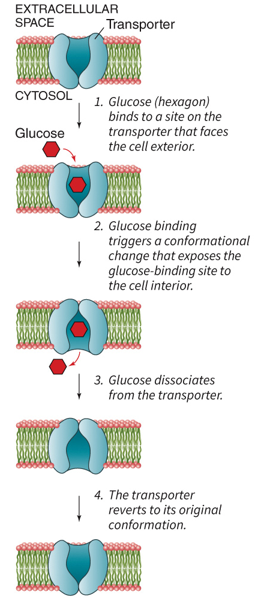
What is the shape of the curve in regards the graph of passive transport using a transporter proteins?
Hyperbolic
upper limit to the speed of transport
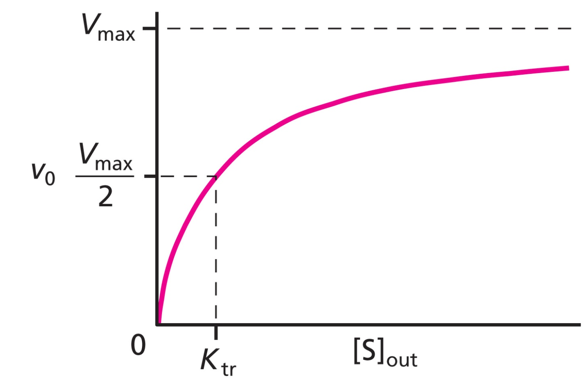
What are the 3 classifications for transporter proteins?
Uniport
Symport
Antiport
What are the 2 types of active transport?
Primary
Secondary
Primary vs. Secondary active transport?
For both, solutes on their own = not favorable
Primary = uses ATP or other rxn as source of E
Secondary = uses ION gradient as source of E
As a result, net delta G = favorable (negative)
Transport protein vs transporter protein
Transport = channels, pores, Active + passive transporter/carrier proteins
Transporter = Active and passive transporters
Which transport proteins have an upper/Max V / is saturable with substrate?
Transporter proteins
Passive
Active
primary + secondary
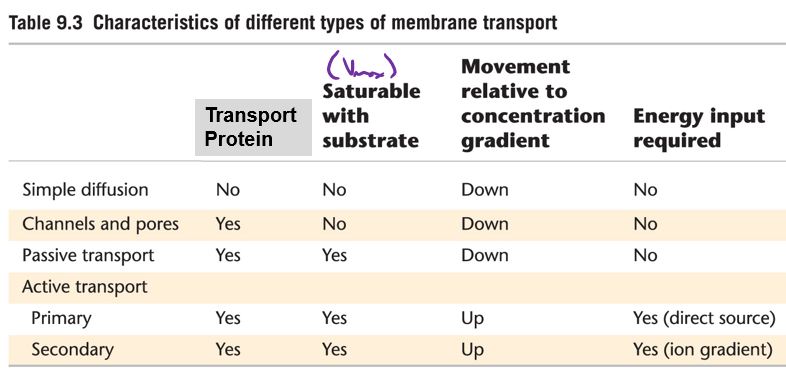
What type of transport protein is an Na+/K+ ATPase
Primary Active transport
It uses ATP + H2O to transport the 2 ions AGAINST their [ ] gradients
How many Na+ and K+ transported by Na+/K+ ATPase and in what direction?
3 Na+ OUT
2 K+ IN
True or false: the [ ] gradient cause by the ATPase are used as the source of E for various Secondary active transport
TRUE
high [Na] out
High [K+] In
**Overview of how Na+/K+ ATPase works?
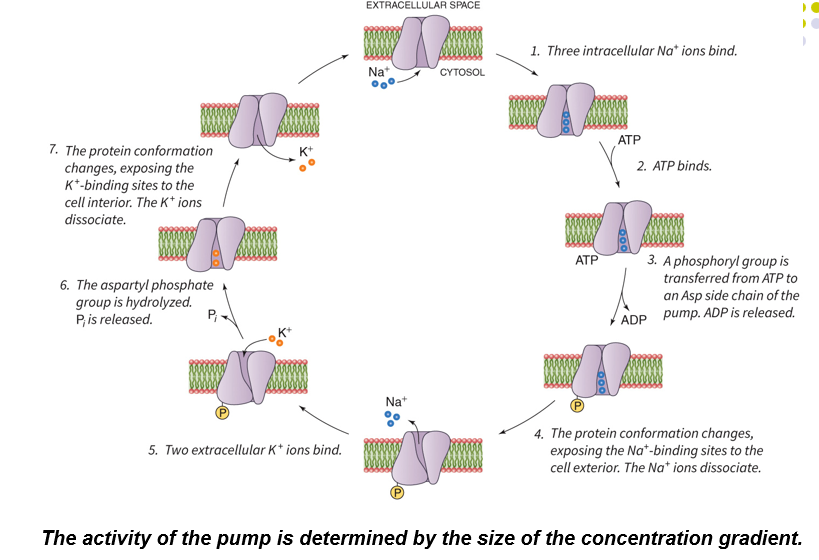
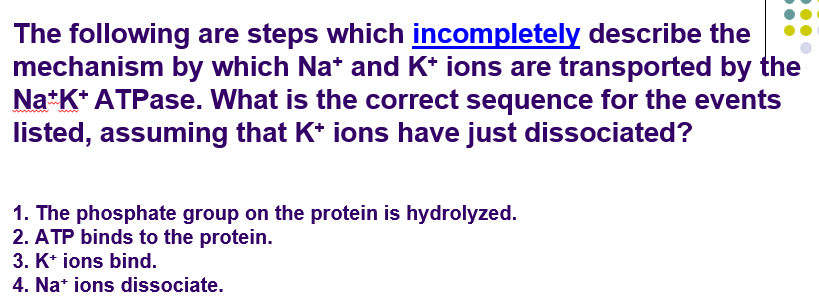
2431
Na+ binds, then ATP, (2) Phosphorylation + conformational change, Na+ ion dissociates, (4) K+ binds, (3)Phosphate hydrolyzed, (1) conformational change = K+ dissociate inside
Na/K ATPase = Electrogenic antiport. What is an electrogenic antiport?
Antiport that creates a charge gradient
What type of transporter is the Na+/Glucose transporter?
Secondary Active transport SYMPORTER
How does the Na+/Glucose symporter work?
Glucose piggybacks on the favorable [ ] gradient of Na+
![<p>Glucose piggybacks on the favorable [ ] gradient of Na+</p>](https://knowt-user-attachments.s3.amazonaws.com/8b3fdc3c-53a8-4b5e-b08a-2d2369199e70.png)